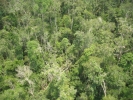 NASA satellites picked up signals of potential deforestation across extensive parts of Latin America, West and Central Africa, and Southeast Asia between July 1 and September 30, according to the latest update on Mongabay.com's Global Forest Disturbance Alert System (GloF-DAS). In Latin America areas with a particularly large number of potential deforestation signals include the Pacific coast regions of Colombia and Ecuador, Southern Venezuela, Bolivia's Chaco, and the Brazilian state of Parà.
NASA satellites picked up signals of potential deforestation across extensive parts of Latin America, West and Central Africa, and Southeast Asia between July 1 and September 30, according to the latest update on Mongabay.com's Global Forest Disturbance Alert System (GloF-DAS). In Latin America areas with a particularly large number of potential deforestation signals include the Pacific coast regions of Colombia and Ecuador, Southern Venezuela, Bolivia's Chaco, and the Brazilian state of Parà.
In Asia, Myanmar and Indonesian Borneo showed signs of significant deforestation; while in Africa, forest change signals were concentrated in West and Central Africa, particularly Liberia, Cote d'Ivoire, Nigeria, Cameroon, Gabon, and Democratic Republic of Congo.
GloF-DAS relies on NASA's Moderate Resolution Imaging Spectroradiometer (MODIS) sensor to detect changes in forest greenness cover relative to the year-earlier period. It registers change when more than 40 percent of a five by five kilometer surrounding forest area has lost greenness over the previous 12 months. Seasonal variation is generally mitigated through the product's quarterly baseline, although changes in some parts of the world, like boreal regions, can be affected by snow and ice distribution.
The tool can help highlight areas where deforestation and forest degradation is occurring on a quarterly basis, potentially providing insight to policymakers, civil society, local communities, and academics. GloF-DAS was developed in partnership with Cal State Monterey Bay and NASA Ames Research Center. GloF-DAS data is downloadable at the Mongabay.com's web site for use in maps and other applications.


